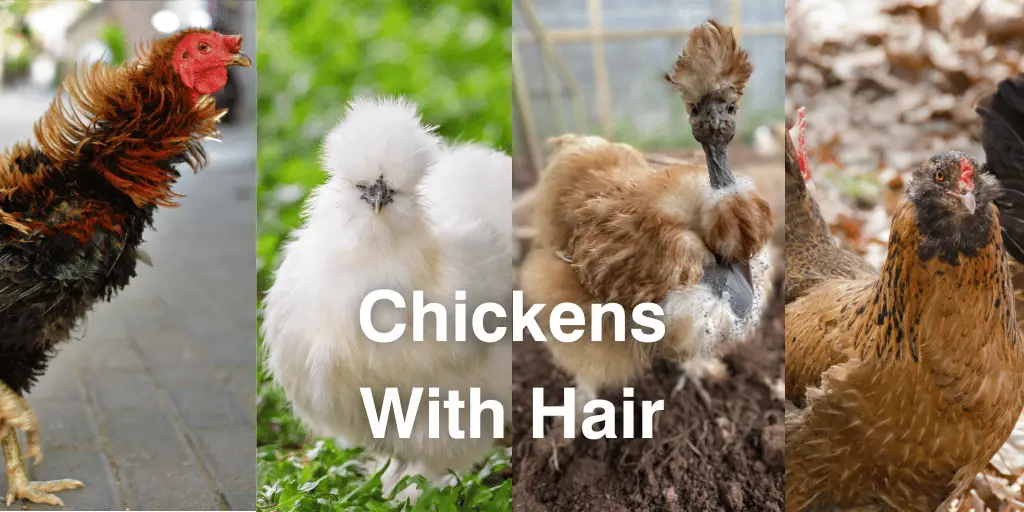Have you heard of chickens with hair? Well, it’s an interesting thing when anyone hears about it.
Chickens are not known for being fluffy. But there are some cool breeds that look like they have hair!
Some birds feel soft like little clouds. Other birds have fancy feather styles. These chickens show a different hairy look on their body.
Some have feathers that are so soft and fluffy. Few have hairy feathers around their faces that make them seem like they have beards or mustaches.
These hairy chickens might not lay as many eggs as other breeds, but the way their feathers look hairs is entirely different.
Few chicken feathers are just super long or fancy. Giving them that unique long hair look.
Whether you love chickens or are just curious about them, chickens with hair like feathers look crazy.
They’re a fun reminder that chickens can be as surprising and adorable as any furry friend!
21 Best Breeds of Chickens With Hair
Below is the list of a few crazy chickens with hair like feathers. Few have a hairy appearance on their head, few on their back and few on their legs.
1. Silkies

Silkie chickens are a unique breed known for their distinct looks and gentle nature. From China, they have a long history, with mentions dating back to the 13th century.
Silkies stand out with their remarkable feathering, which looks like soft, fur patterns. This makes them in the list of chickens with hair on their body.
They look very different from regular chickens. They are tiny and have a round, sturdy body shape. Silkies have blue-black skin and bones, which is unique.
They also have five toes on each foot instead of four. Another special feature is their fuzzy feathers that look like hair. These feathers can be white, black, blue, or buff-colored.
Silkies have a walnut-shaped comb on their head, small wattles, and turquoise earlobes.
They are calm and friendly birds, making them great pets to have in a flock. While they don’t lay many eggs, they do lay about 100 to 120 small cream-colored eggs each year.
But Silkies are appreciated for being good mothers. They usually weigh between 1.5 to 3 pounds, with the females being a bit smaller than the males.
Even though they are tiny, Silkies are tough birds that can live in different climates and housing.
Silkies also tend to live longer than other chicken breeds, often up to 7 or 8 years if cared for properly.
2. Faverolles

Faverolles chickens come from France. These birds have a special look and friendly nature.
People started raising them in the 1800s. Faverolles are known for their soft, fluffy feathers that seem more like hair than normal feathers.
This feature makes them one of the best breeds of chickens with hairy feathers. Faverolles have a medium build with a round shape.
They have one single or pea type comb and small wattles. Their beards and muffs make them look cute.
Their legs have feathers down to their toes, adding to their fluffy look. Faverolles come in different colors like salmon, white, black, blue, and cuckoo.
Faverolles are good for both eggs and meat. They don’t lay the most eggs, around 150 to 200 light brown ones per year.
But they have a calm nature, making them great for backyard flocks. Faverolles are also good at hatching and caring for chicks from other breeds.
Faverolles chickens are medium-sized. Hens usually weigh 6 to 7 pounds. Roosters weigh 8 to 9 pounds.
They are sturdy birds and can live up to 6 or 7 years, longer than some other chicken breeds.
3. Sultans

Sultan chickens are interesting birds from Turkey. People started keeping them in Europe in the 1700s.
They look fancy and have a royal style. Most people see them as pretty birds, not working birds.
The special thing about Sultans is their feathers. They look like hair, not regular feathers. That’s why they’re in this list of chickens with hair.
Sultan chickens are small and round. Their combs are V-shaped and their wattles are tiny, which makes them look fancy.
Their legs and feet have lots of feathers too. They come in white, black, blue, and other colors. Each color looks beautiful.
Most people keep Sultan chickens just to look at them. They don’t lay many eggs, only about 50 to 70 small white eggs each year. But they make up for it by being so pretty and graceful.
Sultan hens weigh 4 to 5 pounds, and roosters weigh 5 to 6 pounds. Their small size makes them perfect for small home pets.
Sultans are small but tough birds. They often live a long time, up to 8 or 9 years, with proper care and housing.
People like to keep them in their flocks or show them off at exhibitions and competitions.
4. Showgirls

Showgirl chickens have a unique and eye-catching appearance. They are a mix of Silkies and another breed with a featherless neck, called Naked Neck chickens.
It’s not entirely clear where Showgirls came from, but they became popular in the United States in the late 1900s.
Showgirls stand out because of their feathers, which look more like hair than regular feathers. This gives them the tag of chickens with hair on their body.
They are small to medium-sized, with a round body like Silkies. They usually have a single type comb and small wattles.
Their most distinct feature is their partly featherless neck, showing their blue or gray skin underneath.
Showgirls also have feathered legs, adding to their unique looks. They come in many colors and patterns, including black, white, blue, and splash.
They are raised mainly for their beautiful looks and as show birds but also lay many eggs, about 100 to 150 small cream-colored eggs per year.
In size, Showgirls are similar to Silkies, with hens weighing 2 to 3 pounds and roosters 3 to 4 pounds. This makes them good for smaller homes.
Showgirls are tough birds and can live for 7 or 8 years with good care and housing. People like their unique looks and calm nature.
5. Frizzles
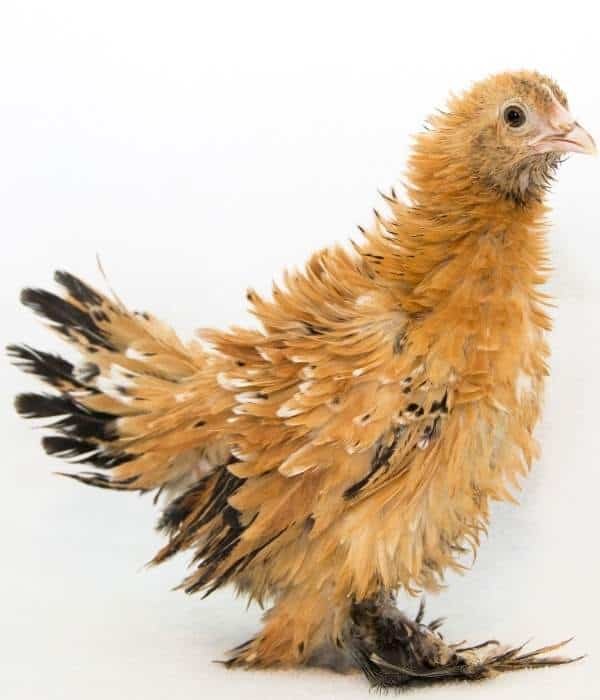
Frizzle chickens have a very interesting appearance with unique feathers. They are believed to have started in Asia, especially Southeast Asia, centuries ago.
This type of chicken became popular in Europe in the 1800s. The most noticeable thing about Frizzles is their frizzled feathers.
Instead of lying flat, the feathers curl outwards, making the chickens look fluffy and almost “hairy.” This is why they are chickens with hair like feathers.
Frizzles are chickens with medium-sized bodies with round and compact shape. They have one comb and small wattles.
Their legs are clean and sturdy. Frizzles have frizzled feathers all over, including the wings and tail. This gives them a special, eye-catching look.
Frizzles come in different colors like white, black, blue, and buff. Each color shows the frizzled feathers in its own way. People keep Frizzle chickens as pets or for decoration.
Hens only lay around 120 to 150 small to medium eggs per year. However, Frizzles are valued for their beauty and uniqueness.
In size, they are similar to other medium chickens. Hens weigh around 5 to 6 pounds. Roosters weigh around 6 to 7 pounds.
They can adapt to different climates and environments well. Frizzles often live up to 8 or 9 years.
6. Brabanter
Brabanter chickens come from the Brabant region in Belgium. They have a rich history going back many centuries.
These birds are known for their unique feathers. Instead of normal feathers, they have feathers that look like fine hairs on their head.
This makes them one of the best hairy feathered chickens. For a long time, Brabanters have been valued for their special looks and for laying eggs.
Brabanters are chickens with a medium body size. They have a compact, rounded shape.
They have a V-shaped comb and medium-sized wattles. Their most noticeable feature is a crest of feathers on their heads.
This crest gives them a regal, distinguished look. Brabanters have clean, sturdy legs with four toes on each foot.
These chickens are raised for their striking appearance and as show birds but they are also good egg layers.
Hens lay around 150 to 200 medium white eggs per year. This makes them a valuable addition to backyard flocks.
In size, Brabanter hens weigh between 6 to 7 pounds. Roosters weigh 7 to 8 pounds.
They can adapt to different climates and environments. With proper care, they can live up to 7 or 8 years.
7. Cochins
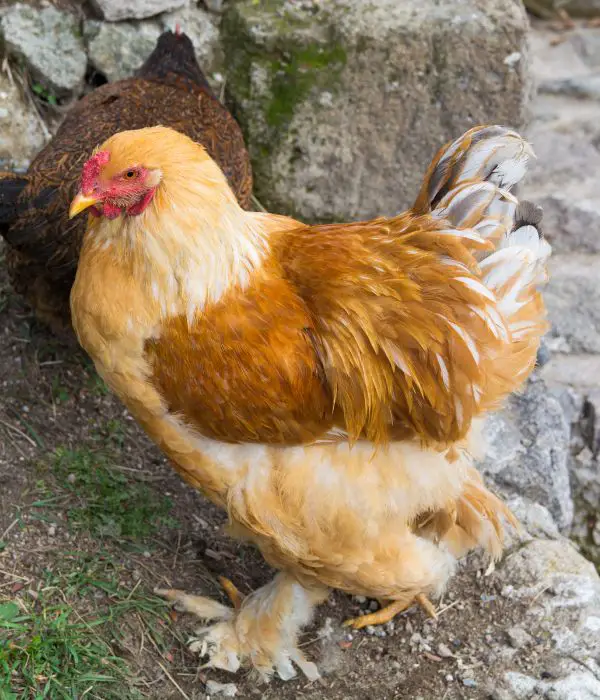
Cochin chickens originated in China in the 19th century. They are well-known for their distinct appearance and gentle behavior. Cochins are very popular worldwide.
A notable feature is their abundant, soft, fluffy feathering. It resembles fine hair rather than feathers.
Cochins are big and heavy with a round, compact body. They have a single comb and medium-sized wattles, along with strong legs.
Their body covered in soft, fluffy feathers, including their legs and feet, giving them a cuddly look. They come in various colors like buff, black, blue, and white.
Cochin chickens are kept for their beauty and calm nature. They lay a good amount of eggs, around 150 to 180 medium to large brown eggs per year.
Cochins are one of the largest chicken breeds with broody nature hens. Hens weigh between 8 to 10 pounds, and roosters weigh 11 to 12 pounds.
They are easy to tame and are great for backyard flocks and families. With proper care, they often live up to 8 or 9 years.
8. Pavlovskaya

The Pavlovskaya chicken from Russia has a special place in poultry history. This breed’s roots go back to the 17th century.
The Russian nobility bred it for its looks and ability to withstand cold. One striking feature of the Pavlovskaya is its feathering.
It looks remarkably soft and fine, like delicate hair rather than traditional feathers. This is why this breed is in this list of top chickens with hair.
The Pavlovskaya is a small to medium-sized chicken breed. Its body is round and compact. It has a V-comb, small wattles, and sturdy legs.
The most distinct feature is its unique color mix of gold, black, and copper. The legs have feathers down to the toes, giving it a special look.
Pavlovskaya chickens are raised for their beauty and historical value, not for egg production.
Hens lay around 100 to 150 small to medium eggs per year. They are small, with hens weighing 4 to 5 pounds and roosters 5 to 6 pounds.
Despite their small size, Pavlovskaya chickens can handle cold and harsh conditions due to their Russian origin. With proper care, they live up to 7 or 8 years.
9. Onagadori
The Onagadori chicken from Japan has a long history spanning many centuries. The feathers of these chickens are long, soft, and flowing, resembling hair rather than typical feathers.
This makes the Onagadori a notable example of chickens with hair chickens. The Onagadori is a graceful breed of chicken.
It has a long, slender body and a tail that can grow over 20 feet long in adult roosters. These feathers are carefully cared for and considered a symbol of beauty in Japanese culture.
Onagadoris have single type comb and small wattles on their heads. They also have clean, slender legs that add to their elegant look.
These chcikens are mainly kept for their looks and cultural importance, not for laying eggs. They are valued for their stunning appearance and history.
Onagadori hens only lay around 40 to 60 small white eggs per year. Their main purpose is to show off their beautiful feathers and continue their breed.
They are a moderate size. Hens typically weigh between 5 to 6 pounds. Roosters usually weigh 6 to 7 pounds.
With proper care, Onagadori chickens can live a long time – often up to 10 years.
10. Yokohama
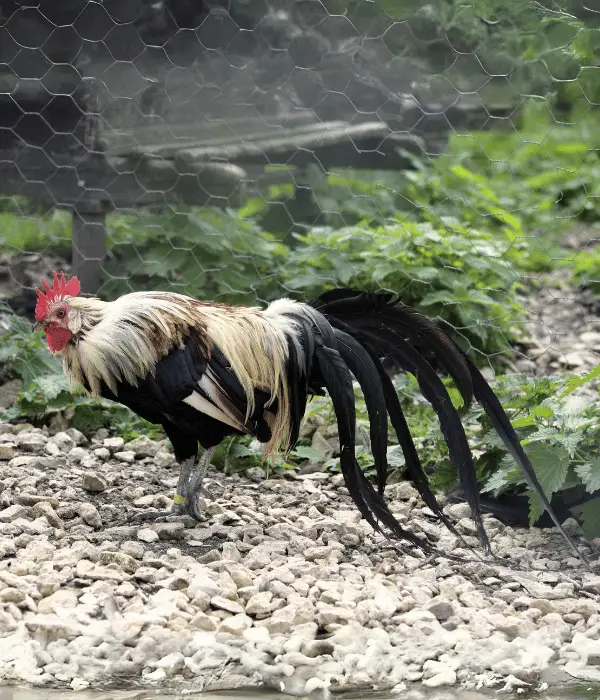
The Yokohama chicken comes from Japan. It has an interesting history dating back to the mid-1800s. Yokohamas were bred from long-tailed Japanese chickens.
They were developed to be elegant, striking birds kept for their beauty. Their feathers are remarkable: they look more like fine hairs than typical feathers.
This makes Yokohamas name in this list of chickens with hair. They have a walnut or pea type comb and small wattles.
Their legs are clean and slender, adding to their elegant look. They come in different colors and patterns like Red, White, Black.
People mainly raise Yokohama chickens for ornamental purposes and as show birds. This is because of their striking appearance and historical significance.
Yokohama hens don’t lay many eggs, only around 100 to 150 small to medium-sized eggs per year. Their main purpose is to showcase their stunning plumage and maintain their breed.
In terms of size, Yokohama hens weigh between 4.5 to 5.5 pounds, and roosters weigh 5.5 to 6.5 pounds. They often live up to 8 or 9 years with proper care.
11. Thuringian Chicken
Thuringian chickens come from the Thuringia region of Germany. They have a rich history dating back several centuries.
One of their most notable features is their soft, fine feathering around face. It appears remarkably delicate, resembling hair rather than traditional feathers.
Thuringian chickens have a medium body. Their shape is sturdy and rounded. They have a small single type comb and wattles. Their legs are clean and strong.
Thuringians have soft, fluffy feathers covering their entire body. This gives them a plush, cuddly look. They come in different colors likeWhite, Yellow, Silver Spangled, Chamois Spangle, Gold Spangle, Black, Blue, Partridge, and Cuckoo.
They are not the best for high egg laying. But hens lay around 150 to 200 medium-sized brown eggs per year. They have a relatively long lifespan up to 7 or 8 years.
They are hardy, reliable and can adapt well to various weathers. Hens usually weigh between 6 to 7 pounds. Roosters weigh from 7 to 8 pounds.
12. Phoenix Chicken

The Phoenix chicken from Japan has a fascinating history dating back to ancient times. They were bred for their ornamental qualities.
Phoenix chickens are known for their striking appearance and docile behavior. One distinct feature is their hair like feathering.
It is remarkably long and flowing, resembling delicate hair strands rather than traditional feathers. So, they are one of the best chicken breeds with hairy feathers.
Phoenix chickens have a slender, graceful body with a very long tail feathers. They have a single type comb and small wattles.
Their legs are clean and short, adding to their elegant look. The most noticeable trait of Phoenix chickens is their beautiful feathers in colors like golden, silver, and black-breasted red.
Phoenix chickens are mainly kept for their looks and as show birds due to their attractive appearance and history.
They are not known for laying many eggs. Hens lay around 50 to 60 small white eggs per year.
Their purpose is to showcase their stunning hairy feathers and continue their breed.
Phoenix chickens are medium-sized. Hens weigh between 4.5 to 5.5 pounds, and roosters weigh 5 to 6 pounds. They can up to 8 or 9 years with proper care.
13. Polish
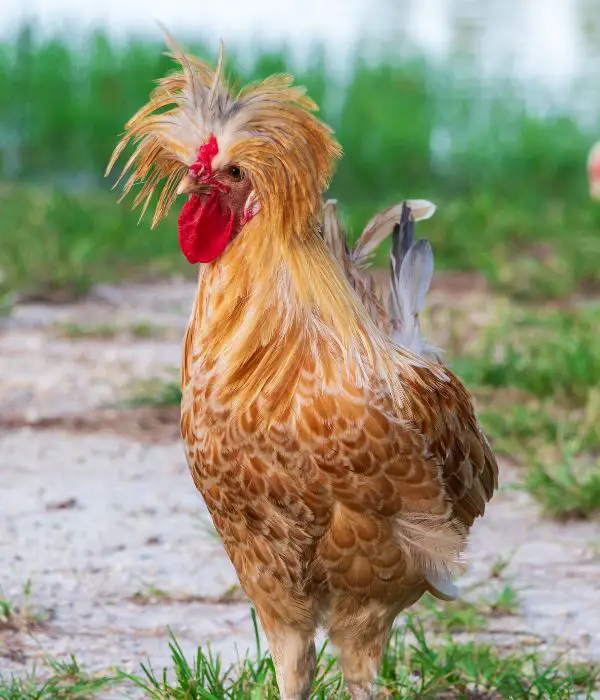
Polish chickens originally came from the Netherlands, despite their name. They have a long, fascinating history going back many centuries.
They are known for their striking looks and gentle nature. One of their most recognizable traits is their unique feathering.
Their feathers appear soft and fine, like delicate hair rather than normal feathers. This makes them in the list of hairy feathered chickens.
Polish chickens have a round body shape. They have big feathers on top of their head called a “top knot.” These chickens also have small V-comb and wattles.
They have slim, clean legs. Polish chickens come in different colors like white, black, golden buff, and silver laced.
Polish chickens are raised for their looks and to show at events. They do not lay many eggs, only about 140-150 small white eggs per year.
But they make up for it with their charm and beauty. Polish hens weigh about 4.5 to 6 pounds. Roosters weigh around 6 to 7 pounds.
Polish chickens are tough birds. They can live in different environments. They have a medium lifespan of about 6 or 7 years with good care.
14. Houdans
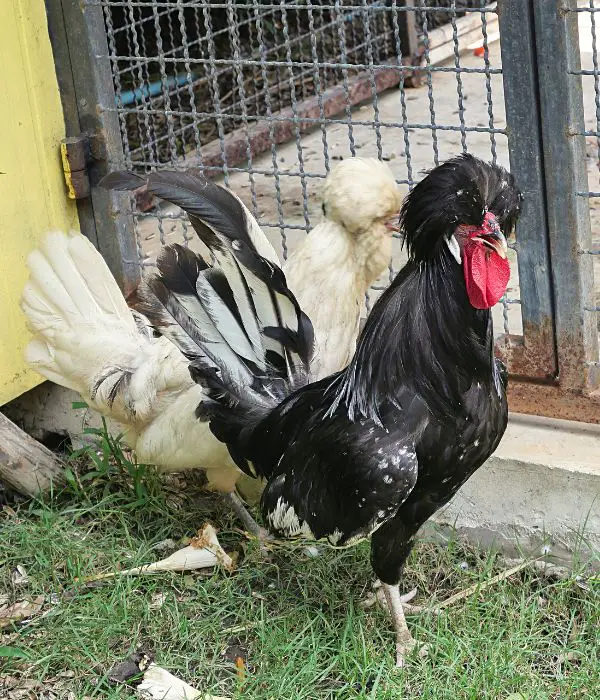
Houdans are chickens from France. They have an old history dating back to the 1800s.
Houdans look unique and can be raised for eggs and meat. Their feathers seem soft and fine, like hair on their head. That’s why they are one of the popular chickens with hair like feathers.
Houdan chickens have a medium size and round shape. Their comb and wattles are small and neat. Houdan chickens have strong, clean legs that look elegant.
They come in different colors and patterns like mottled and black, making them look unique and beautiful.
Houdan chickens are raised for both eggs and meat. They lay 150 to 180 medium-sized white eggs per year.
The hens of this breed usually weigh 5 to 6 pounds, and roosters weigh 6 to 7 pounds.
Despite their fancy look, Houdan chickens are hardy.
They can adapt to different climates and environments. They have a moderate life expectancy of 7 to 8 years.
15. Appenzeller Spitzhauben
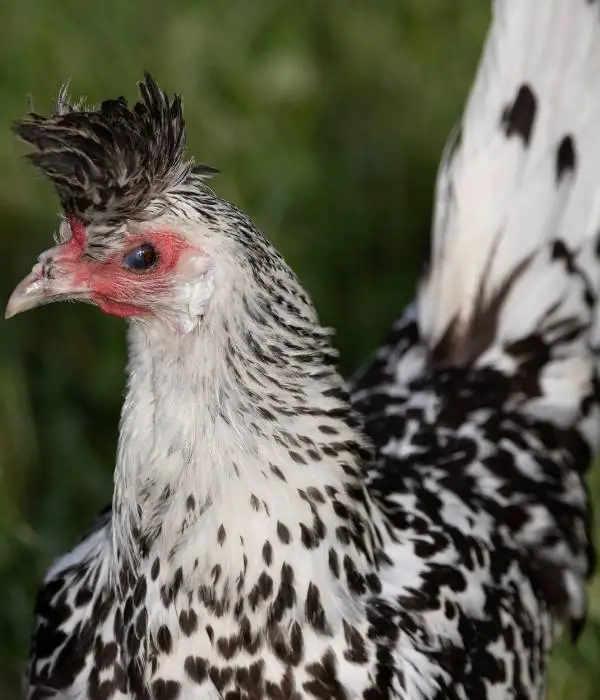
The Appenzeller Spitzhauben chicken from Switzerland has an interesting history dating back centuries. This breed is loved for its striking looks and hardiness.
Its most unique feature is its feathering on the head looks like hair style. This makes the Spitzhauben a prime example of hairy feathered chickens.
The Appenzeller Spitzhauben is a slim and graceful chicken breed. It has a crest of feathers on its head that looks like a pointed hat.
Spitzhaubens have small combs and wattles. Their legs are thin and neat. This breed comes in Silver Spangled, Black, Gold variety.
Appenzeller Spitzhauben chickens are useful for both eggs and meat. They lay around 150 to 180 medium-sized, white eggs per year.
Though the egg production is good and they are reliable hens.Spitzhauben hens weigh 4 to 5 pounds. Roosters weigh 5 to 6 pounds.
Despite their fancy looks, Appenzeller Spitzhauben chickens are hardy. They can adapt to different climates and environments. With proper care they live 6 or 7 years.
16. Sanjak Longcrower Chicken

The Sanjak Longcrower chicken comes from Turkey. It has a unique history and appearance. Its head feathers looks like hair and erected upward.
They have a slim, elongated body. The breed has small, V-shaped combs and wattles. Its legs are thin and elegant.
Sanjak Longcrowers come in various colors including black, blue, mottled, and white. These chickens are bred mainly for their loud and lasting crow.
This special ability makes them popular among chicken lovers. Though they don’t lay many eggs, around 100 to 150 small to medium-sized ones yearly, their purpose is to show off their looks and crowing skills.
In size, Sanjak Longcrower hens weigh 5 to 6 pounds while roosters weigh 6 to 7 pounds.
Despite being ornamental birds, Sanjak Longcrowers are hardy as they easily adapt to various climates and environments. With good living conditions, they often live up to 7 or 8 years.
17. Japanese Bantams
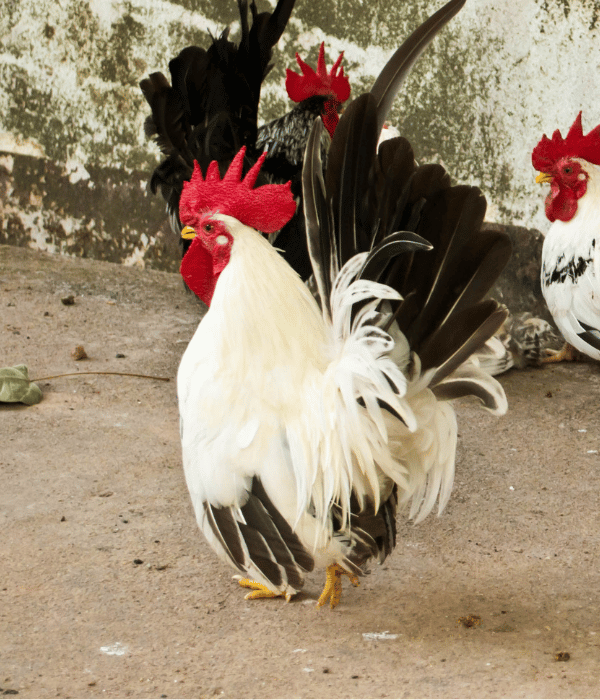
Japanese Bantams have a long history dating back centuries in Japan. These small chickens are famous worldwide for their unique looks and charming nature.
One key feature is their soft, fine feathering around their neck and back. These feather looks like hairs on their body.
Japanese Bantams are small chickens with a round body and short legs. They look very cute and tiny.
They have a small single comb and wattles. Japanese Bantams come in different accepted varieties Black, Barred, Brown Red, Black tailed Buff, Black tailed White, Gray, Mottled, Wheaten and White.
People keep Japanese Bantams as pets or for decoration because they are small and friendly.
Japanese Bantam hens lay around 50 to 80 small white eggs in a year. The hens usually weigh between 1 to 1.5 pounds and roosters weigh between 1.5 to 2 pounds.
Even though Japanese Bantams are tiny, they can live in different climates and environments. With good care and coop, Japanese Bantams can live up to 6 or 7 years.
18. Ameraucanas

Ameraucana chickens are a modern breed made in the United States in the 1970s. They lay blue eggs like their ancestors, the Araucana chickens from South America.
These chickens have very soft muff and beard feathers look like hair. This makes them look like chickens with hair on their face areas.
Ameraucanas are chickens with a medium body size. They look strong and well-built.
Ameraucanas have a pea comb and rounded wattles. Their legs are clean and sturdy, adding to their overall look.
These chickens come in various colors like black to white, blue to wheaten, making them visually appealing. These chickens have a lifespan of 6 to 7 years.
People raise Ameraucana chickens mainly for their blue or green eggs. These chickens have a calm nature, making them great pets for backyards and families.
Ameraucanas lay around 150 to 200 medium-sized eggs per year. The hens weigh between 5 to 6 pounds, and the roosters weigh 6 to 7 pounds.
19. Araucanas
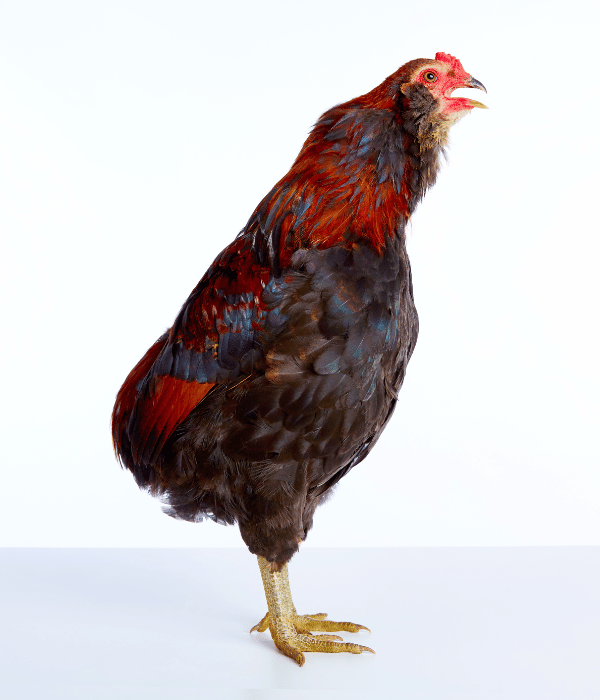
Araucana chickens originated in South America and have a fascinating history dating back centuries.
Indigenous peoples in the Araucanía region of Chile bred these chickens, which initially roamed wild before being domesticated.
Araucana chickens have a medium-sized body that is rounded and compact.
They have small, round wattles and a pea comb. Their legs are sturdy and clean. These chickens are known for not having a tail, which is called “rumplessness.”
They also have tufts of feathers with a hairy appearance on their cheeks, called “ear tufts.” Araucana chickens are raised mainly for their blue eggs.
This is rare and special for people who like chickens. They lay around 150 to 200 medium-sized blue eggs per year.
They are not known for producing a lot of meat. However, their special eggs make them valuable for both egg production and showing off.
Araucana hens usually weigh between 4.5 to 5.5 pounds. Roosters weigh from 5.5 to 6.5 pounds.
Even though they are small, Araucana chickens are hardy ones. They can adapt to different climates and environments.
Their life expectancy is around 6 or 7 years with good living environment. Their unique looks, blue eggs, and history make them a popular breed.
20. Crevecoeur Chicken
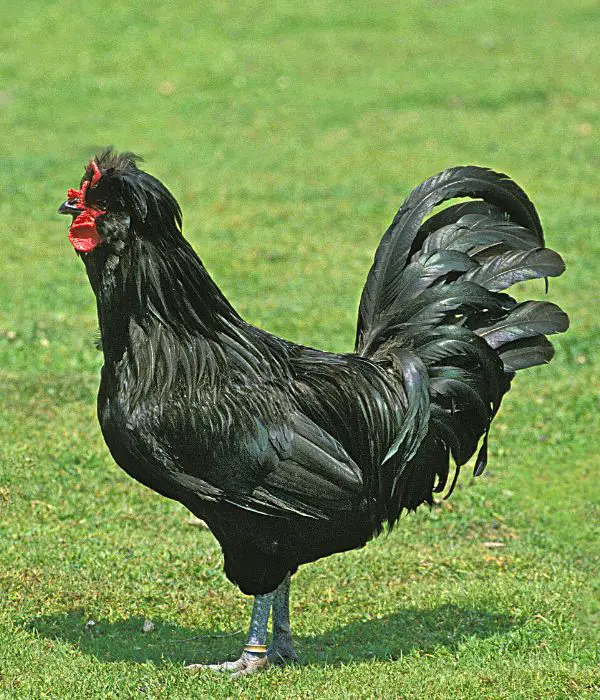
The Crevecoeur chicken breed comes from France. It has a long history that goes back hundreds of years.
The breed likely started in Normandy. These chickens are known for their unique look.
The feathers of this chicken breed can seem like fine hair on their bodies. Crevecoeur chickens have a medium-sized body that is compact and rounded.
They have a V-shaped comb and wattles. Their legs are clean and sturdy, which adds to their elegant appearance.
One special feature of Crèvecoeur chickens is their distinct black feathers. This makes them different from many other breeds.
In the past, people raised Crevecoeur chickens for both meat and eggs. The hens lay a moderate number of large white eggs each year.
But now, people mostly keep them for shows and as ornamental birds because of their unique look and historical importance.
Their striking appearance and gentle nature make them great additions to backyard flocks. Crèvecoeur hens typically weigh between 6 to 7 pounds, and roosters weigh a bit more.
With proper care, Crèvecoeur chickens can live up to 6 or 7 years. This makes them a relatively long-lived breed compared to some others.
Their uniqueness comes not only from their striking look but also from their historical importance as one of the oldest French chicken breeds.
Today, they continue to fascinate poultry lovers with their beauty and heritage. They remind us of France’s rich agricultural traditions.
20. Easter Eggers

Easter Eggers are fun chickens with colorful eggs. They come from mixing different breeds in the United States. Some of their parents were likely Araucanas or Ameraucanas.
That’s why Easter Eggers lay such pretty eggs. Their feathers can be really different colors and patterns. Some even look like they have hair, which is cool.
Easter Eggers are medium-sized chickens. They can have single, pea, or rose combs on their heads.
They also have small wattles and sturdy legs. Their bodies can look a bit different based on their parents. But they’re usually a nice medium size.
The best part is how many colors they come in! Brown, black, white, blue, and green Easter Eggers are all possible.
People like keeping Easter Eggers for their eggs and friendly personalities. Their eggs can be blue, green, pink, or brown.
Easter Eggers usually lay 150 to 200 medium eggs each year. That’s a good number of pretty eggs. As for size, the hens weigh around 4 to 6 pounds.
The roosters are 5 to 7 pounds. So they’re not too big or too small.
Easter Eggers are a type of chicken that can live for up to 6 or 7 years if properly cared for and housed. They lay colorful eggs consistently and make good companions.
Their unique looks, friendly nature, and egg-laying ability make them a popular choice for backyard flocks and hobby farmers who want both beauty and usefulness in their chickens.
FAQs About Chicken Hair
Do Chickens Have Hair?
Chickens do not have hair like mammals. Instead, they have feathers covering their bodies. Feathers keep chickens warm, protect them, and help some breeds fly.
While feathers and hair made up of same protein, keratin but their structures and purposes differ.
However, certain chicken breeds appear to have fine, soft feathering resembling hair, especially on their necks or heads.
What Chickens Have Hairy Feet?
Chickens with feathered or “hairy” feet are known as “feather-footed” or “hairy-footed” breeds. The Cochin chicken is one well-known breed with this trait.
Cochins have feathers covering their legs and feet, giving them a fluffy look. Other feather-footed breeds include Brahmas, Silkies, and Sultans.
These chickens have feathers extending down their legs and even covering their toes, creating a unique, ornamental appearance.
Feathered feet provide extra insulation and protection, especially in cold climates. They are also a distinctive feature valued in exhibition and ornamental poultry breeding.
Why Does My Chicken Have Hair?
Sometimes, chickens can look like they have hair instead of feathers. This is due to special feathers that are thin and soft, kind of like hair.
These feathers often grow on the chicken’s neck or head. We call these breeds “chickens with hair” or “hairy feathered chickens.” But it’s not real hair – chickens can’t grow hair like people or animals. Their “hair” is just a different type of feather.
The feathers may look like hair, but they’re still made of keratin, the same material as regular feathers and human nails.
Having these unique feathers makes some chicken breeds look special and interesting.
Do Chickens Have Hair on Their Body?
No, chickens don’t actually have hair like mammals. They have feathers that cover their whole body. Feathers keep chickens warm and dry, and some feathers help them fly.
Feathers and hair are both made of keratin protein. But feathers are different – they’re designed for warmth, weather protection, and sometimes flight.
Hair just keeps mammals insulated and protected. However, certain chicken breeds grow feathers that are so fine and soft, they resemble hair more than normal feathers.
People sometimes call these “hairy chickens.” But even though the feathers look like hair, especially on the neck and head areas, chickens can’t grow true hair. Their “hair” is just a special type of feather.
Summary
The world of poultry is filled with many chicken breeds. Each one has its own special looks and qualities.
This article talks about 21 chickens with feathers that look like hairs on their bodies. These include the pretty Silkies, majestic Cochins, historic Crèvecoeurs, and colorful Easter Eggers.
Their feathering makes them look really unique. These chickens with hair-like feathers add charm and wonder to any backyard flock.
Just imagine Silkies strolling through the garden with their soft, fluffy feathers swaying in the wind.
Think about a big Cochin rooster with lots of feathers flowing down its legs like fur. Chickens like these make any poultry lover’s backyard look even more beautiful.
Beyond their good looks, these chickens also bring diversity to backyard flocks. Their special traits and personalities make them fun companions for hobby farmers, homesteaders, or families who want to connect with nature.
For example, the ancient Silkies were prized for their ornamental beauty in Chinese culture. The historic Crèvecoeurs played a role in French farming traditions.
Each breed has a story showing how resilient, adaptable, and clever humans can be. It makes things look nicer. It also makes having chickens more fun.
